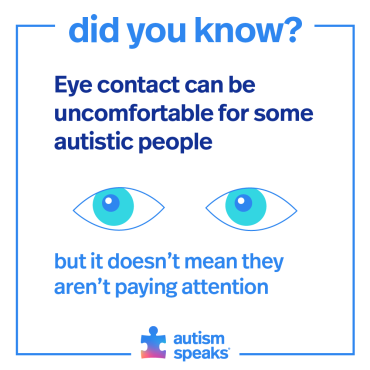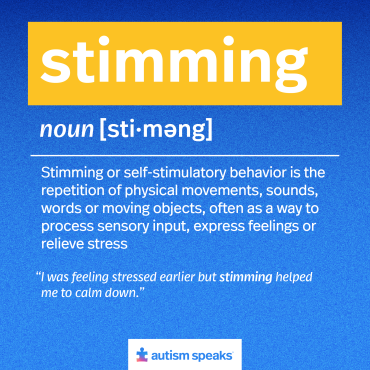Autism symptoms
What are the symptoms of autism?
The two core autism symptoms are:
- Challenges with social communication and interaction skills and
- Restricted and repetitive behaviors
While autism spectrum disorder (ASD) looks different from person to person, doctors look for these two symptoms when making a diagnosis. They also rate the severity of these symptoms based on the level of daily support the person requires. Severity levels range from level 1 (“requiring support") to level 3 (“requiring very substantial support”). Not all people with ASD present these two core symptoms the same way. Additionally, some people without ASD may exhibit these signs.
Social communication and interaction skills
Children and adults with autism may have difficulty with social interaction and communication skills, particularly in these three areas:
- Social interactions
- Starting and taking turns in conversations
- Sharing interests or emotions
- Understanding what others are thinking or feeling
- Communication
- Making eye contact
- Understanding other people’s body language, gestures and facial expressions
- Regulating tone of voice (e.g. they may speak too loudly, too quietly and/or with a monotone voice)
- Developing, maintaining and understanding relationships
- Expressing feelings and seeking emotional comfort from others
- Making friends and playing with peers
- Understanding boundaries and personal space
- Feeling overwhelmed in social situations
Restricted and repetitive behaviors
Restricted and repetitive behaviors vary greatly across the spectrum. To get an autism diagnosis, a person must show at least two types of these behaviors:
- Repetitive movements, play or speech patterns
- Stimming, or making repetitive body movements to regulate emotions (e.g. rocking, hand flapping, spinning, running back and forth)
- Lining up toys in a row, spinning wheels, repeatedly flipping switches
- Imitating another person’s speech, repeating words or phrases (also known as echolalia)
- Insistence on sameness and need for routine
- Extreme distress at even small changes in plans or routine
- Ritualistic behaviors (e.g. watching the same videos over and over, repeatedly touching objects in a set order)
- Need for routine (e.g. same daily schedule, meal menu, clothes, route to school)
- Intense and highly focused interests
- Extreme interest or knowledge of specific, narrow topics
- Strong attachment to a certain object (e.g. a toy or figurine)
- Under- or over-sensitivity to sensory stimulation
- Sensory differences, like unusual sensitivity to light, sound, touch or texture
- Lack of sensitivity to pain or temperature
- Sensory-seeking behaviors (e.g. smelling or touching of objects, visual fascination with lights or movement)
Autism characteristics
People may also show other characteristics of autism. These might include:
- Using other kinds of communication besides spoken language (e.g. typing on a computer, pointing to pictures on a tablet, or communicating through behavior)
- Difficulty with executive functioning (e.g. planning how to complete a task, juggling multiple tasks, making decisions)
- Trouble with fine motor skills and coordination
- Needing help with daily living skills
- Difficulty regulating and/or communicating emotions, sometimes resulting in harmful or self-injurious behaviors, sensory overload, meltdowns or shutdowns
Masking autism symptoms
Some autistic people suppress or hide their autism symptoms in order to be accepted or meet societal expectations. This is called masking or camouflaging. Masking might look like pushing through your sensory discomfort in a loud room or forcing eye contact during a conversation. Research shows that masking is more common in girls and women and can cause mental health issues.
Related resources
- Learn about the diagnostic criteria for ASD
- First Concern to Action Tool Kit
- 100 Day Tool Kit for Young Children
- Adult Autism Diagnosis Tool Kit
- Find local providers and services in your area
- Contact the Autism Response Team for help, information, resources and opportunities.


